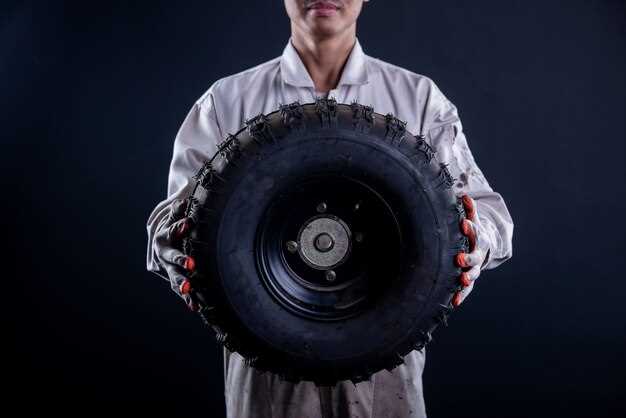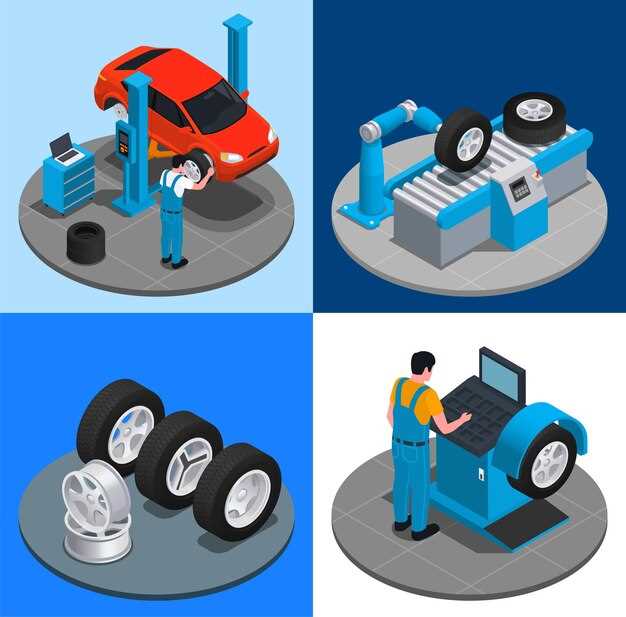Choose dynamic wheel balancing for overall better performance and safety. This method allows for precise distribution of weight across the entire wheel, reducing vibrations and enhancing tire longevity. Properly balanced wheels result in a smoother driving experience and decreased wear on suspension components. Start with dynamic balancing if performance and safety are priorities in your driving.
Understanding the differences between static and dynamic balancing can impact your vehicle’s efficiency. Static balancing focuses on correcting vertical vibrations when the wheel is stationary, whereas dynamic balancing corrects both horizontal and vertical vibrations during wheel rotation. Dynamic balancing typically involves more complex equipment but delivers more comprehensive results for various driving conditions.
The choice between static and dynamic balancing can influence how your vehicle handles the road. For drivers experiencing high-speed travel or uneven tire wear, dynamic balancing provides a nuanced approach to balance by considering both the inner and outer dimensions of the wheel. On the other hand, static balancing can be a suitable choice for simpler setups or when budget constraints are considered.
The cost factor might sway some towards static balancing, as it involves simpler equipment and often lower service charges. However, investing in dynamic balancing could prevent future costs related to tire replacement and mechanical repairs resulting from imbalance-related vibrations. It’s crucial to weigh these factors when selecting the right balancing method for your wheels.
Understanding Wheel Balancing

Maintain optimal vehicle performance by focusing on proper wheel balancing. This process ensures that the wheel’s weight is evenly distributed, preventing uneven tire wear and improving the handling of the vehicle. Two main types of imbalances can affect your car’s wheel alignment: static and dynamic.
Static imbalance occurs when there is a single point of imbalance across the wheel’s plane of rotation. It can lead to vertical bouncing and noticeable vibrations, particularly at higher speeds. To counteract this, technicians identify the heavy spot using specialized equipment and add weights to the opposite side of the wheel.
Dynamic imbalance, on the other hand, is more complex, involving unequal weight distribution on different sides of the wheel and tire assembly. This type of imbalance causes lateral vibrations and can affect the steering of the vehicle. Addressing dynamic imbalance requires adding weights on both the inner and outer planes of the wheel to achieve even distribution.
Regular balancing checks, ideally performed during tire rotations or new tire installations, can help identify and rectify these imbalances. Skipping these checks may result in a rough ride and premature tire wear, reducing the lifespan of your tires and impacting fuel efficiency.
Consider consulting a professional if you experience any unusual vibrations or handling issues while driving. Professional equipment can pinpoint problems more accurately than manual methods, ensuring a smoother ride and extending tire life. Prioritize wheel balancing as an essential part of vehicle maintenance for safer and more enjoyable drives.
Why Wheel Balancing Matters for Your Vehicle
Ensure your wheels are balanced to improve your vehicle’s performance and safety. Unbalanced wheels can cause uneven tire wear, leading to the need for premature tire replacement. Here’s why balancing your wheels is essential:
- Smooth Ride: Feel the difference in driving comfort when wheels are balanced correctly. Vibration from misbalanced wheels can lead to an uncomfortable ride, particularly noticeable at higher speeds. Balancing fixes this by ensuring that the tire weight is evenly distributed.
- Tire Longevity: Protect your investment by preventing uneven tire wear. Balanced wheels ensure even tread wear, extending the life of your tires and saving you money on replacements.
- Fuel Efficiency: Reduce your fuel consumption by maintaining balanced tires. Uneven wear and unnecessary vibrations can increase rolling resistance, making your engine work harder and consume more fuel.
- Vehicle Safety: Preserve your vehicle’s steering and handling capabilities. Vibrations and pulling caused by imbalanced wheels can compromise your ability to control the car, especially during sudden maneuvers or emergency situations.
- Component Longevity: Prevent premature wear on suspension and steering components. Imbalanced wheels put additional strain on these parts, potentially leading to costly repairs.
Regular wheel balancing, particularly when replacing tires or at signs of imbalance, ensures a safer, more efficient driving experience. Schedule a check next time you’re at the auto service shop.
The Basic Principles of Static and Dynamic Balancing
Prioritize understanding the difference between static and dynamic balancing to maintain optimal vehicle performance. Static balancing ensures the wheel’s weight is evenly distributed around the axis. Achieve this by mounting the wheel on a spindle and using counterweights to correct any imbalance detected. Proper static balancing prevents vibration when the wheel spins at low speeds.
Dynamic balancing addresses imbalances along both vertical and horizontal planes, vital for smooth driving at higher speeds. This method uses a dynamic balancer, which rotates the wheel to identify areas of imbalance, allowing precise placement of counterweights on both sides of the wheel. This adjustment reduces lateral movement and provides a smoother ride.
Check wheel balance regularly, especially after tire changes or experiencing vibrations while driving. Consistent attention to both types of balancing not only extends tire life but also enhances vehicle handling and safety. Ensure your mechanic uses the correct equipment, as accurate balancing helps in minimizing wear and ensuring a comfortable driving experience.
Signs Your Vehicle Needs Wheel Balancing
Notice a vibration in your steering wheel that intensifies with speed? This is a clear sign that your vehicle requires wheel balancing. Unbalanced wheels cause uneven distribution of your car’s weight, leading to a wobbling sensation.
Uneven tire wear serves as another indicator. If you spot unusually worn spots on the edges or the center of your tires, balancing might be the solution. This misalignment can lead to premature tire replacement and cost you more money down the road.
Pay attention to your driving comfort. Feeling more road noise than usual? Irregular balancing can cause increased noise from your tires, making your ride less pleasant and smooth.
If your vehicle drifts to one side without steering input, unbalanced wheels might be contributing to the issue. This drift often requires continuous steering adjustment, leading to driver fatigue and reduced control.
Experiencing reduced fuel efficiency? Unbalanced wheels force your engine to work harder to maintain speed, which in turn decreases fuel mileage. Balancing your wheels helps in achieving optimal fuel consumption.
Regular check-ups with a professional ensure that your wheels stay perfectly balanced, promoting safety and extending the lifespan of your tires. Ignoring these signs can lead to more severe issues, costing time and money down the line.
Step-by-Step Wheel Balancing Procedures

Ensure your vehicle is parked on a level surface. Engage the parking brake and secure the wheel with chocks to prevent movement.
- Prepare the Wheel: Remove the hubcap if necessary, and clean the wheel with a brush or cloth to remove any dirt or debris. Check for visible damage, such as bends or cracks.
- Mount the Wheel: Use a wheel balancer to mount the wheel securely. Double-check that it is held firmly to avoid inaccurate readings during measurement.
- Measure Imbalance: Set the wheel balancer to measure imbalance. Allow the wheel to spin, and the machine will identify areas with uneven weight distribution.
- Apply Weights: Based on the balancer’s readings, place adhesive or clip-on weights precisely where needed. Recheck the balance and make adjustments by adding or removing weights until the wheel achieves proper balance.
- Reinstall the Wheel: Carefully remount the wheel on the vehicle. Tighten the lug nuts in a star pattern to the manufacturer’s torque specifications to ensure secure fitting.
- Final Check: Lower the vehicle and perform a test drive. Pay attention to vibrations or handling issues, which may indicate further corrections are needed.
By following these steps, you can maintain optimal tire performance and safety, leading to a smoother ride experience.
Tools and Equipment Required for Wheel Balancing
A wheel balancing process starts with using a quality wheel balancer, a tool that accurately identifies imbalances in your wheels and tires. Choose between static and dynamic balancers based on your requirements. Static balancers are simpler and focus on vertical imbalances, while dynamic balancers address both horizontal and vertical discrepancies for high-speed vehicles.
Include a set of wheel weights, essential for correcting detected imbalances. These weights come in various materials such as lead, zinc, or steel. Select adhesive weights for alloy wheels and clip-on weights for steel rims. An assortment of weights ensures you have the right balance corrections at your fingertips.
A tire changer is invaluable for mounting and dismounting tires without damaging rims. Automated machines expedite the process, enhancing precision and reducing the risk of operator error. Leverless tire changers are particularly effective for delicate alloy rims.
| Tool | Purpose |
|---|---|
| Wheel Balancer | Identifies wheel imbalance |
| Wheel Weights | Balances the wheel post-diagnosis |
| Tire Changer | Mounts and dismounts tires safely |
| Lug Wrench | Removes and secures wheel nuts |
| Torque Wrench | Ensures proper wheel nut torque |
Don’t overlook the lug wrench and torque wrench. The lug wrench assists in removing and tightening wheel nuts, while the torque wrench ensures every bolt is tightened to manufacturer specifications, preventing under-torque or over-torque situations that could lead to safety issues.
Ensure you have a reliable jack for lifting vehicles safely. A hydraulic floor jack offers a stable and dependable solution, providing easy access to the wheels.
Equip your workspace with quality air compressors to operate pneumatic tools. Maintain adequate pressure for optimal performance during tire changes and inflation tasks. With these tools, wheel balancing becomes more precise, efficient, and safe.
How to Perform Static Wheel Balancing at Home
Gather a few basic tools: a balancer, wheel weights, chalk, and a jack. Begin by lifting the car using the jack to remove the wheel. Ensure the car is secure and the wheel is off the ground.
Once removed, place the wheel on the balancer. Observe which side naturally falls downwards, indicating the heavy spot.
Mark the topmost point of the wheel with chalk. This will be the location you’ll counterbalance. Add a small weight opposite to that mark.
Spin the wheel on the balancer again to check if it stops at a different position. If it consistently stops at a new spot, add or adjust the weight accordingly.
Continue this process until the wheel no longer favors any direction and remains stationary. This indicates proper static balance.
Finally, reattach the wheel to the vehicle, ensuring all nuts are securely tightened. Repeat as necessary for the other wheels.
Professional Dynamic Balancing: What to Expect
Consult an expert who uses a computer-assisted wheel balancer. This device spins the wheel and tire assembly to detect imbalances, providing precise readings that allow technicians to apply the correct counterweights. Expect detailed feedback, as the system pinpoints specific areas that require adjustment, facilitating precise weight placement for optimal balance.
Professional services typically include a thorough inspection of tires and rims for damage. Balancing technicians will identify and correct bent rims or tire deformities, which can contribute to balance issues if not addressed. Accurate detection ensures that the balancing process tackles the root cause of any unevenness, enhancing ride quality.
Dynamic balancing also accounts for both static and couple imbalances. Static imbalance occurs when there’s a heavy spot in the tire or rim, while couple imbalance relates to weights on opposite sides that don’t cancel each other out. Professionals ensure that both forms are corrected, leading to a smoother driving experience and prolonged tire life.
During the process, anticipate an explanation of the readings and adjustments used. Understanding how these measures contribute to vehicle performance can enhance confidence in the service and clarify the necessity of timely wheel balancing.
Finally, reliable workshops offer a road test to confirm the success of the balancing. A test drive helps ensure that adjustments have addressed vibrations or other balance-related issues effectively, providing you with confidence and a smoother, safer ride after service completion.
Common Mistakes to Avoid During Wheel Balancing
Ensure proper cleanliness of both the wheel and tire before beginning the balancing process. Dirt, mud, and debris can lead to inaccurate weight distribution and imbalance. Thoroughly clean the areas where the weights will be attached to avoid falls or shifts.
Pay attention to selecting the right size and type of balancing weights. Mismatched weights could alter the balance instead of improving it. Use the correct precision tools to determine the ideal weight required for your specific wheel setup.
Avoid neglecting the valve stems. Heavy or unbalanced valve stems can disrupt the balance, so replace any damaged or overly heavy ones. Evaluate the stems condition during each balancing session to maintain optimal performance.
Recalibrate the balancing machine regularly. Machines that are out of calibration can lead to incorrect readings. Follow the manufacturer’s instructions for maintenance to ensure accuracy and reliability every time.
Don’t overlook tire pressure checks before proceeding with balancing. Incorrect tire pressure can skew balancing results, leading to increased wear or vibrations. Confirm all tire pressures are at recommended levels to maintain consistency.
Ensure proper alignment of the wheel assembly. Misaligned components will affect the balancing outcome. Double-check the mounting to ensure that wheels are seated correctly and aligned with the axle center.
Lastly, consider the type of balancing method–static or dynamic–necessary for your wheel type and driving conditions. Static balancing, suitable for simpler setups, may not be enough for high-speed or high-performance vehicles where dynamic balancing would be more appropriate.
Maintaining Balanced Wheels for Long-term Performance
Schedule regular wheel balancing every 6,000 to 8,000 miles to reduce uneven tire wear and extend the life of your tires. Regular checks and balances will help identify any weight discrepancies that could lead to imbalanced rotation, ensuring smoother rides and improved fuel efficiency.
Inspect your tires for uneven tread wear patterns, which signal imbalance issues. If you notice patterns such as cupping or scalloping, it’s time for a balancing session. Keep your wheels aligned to prevent excess strain on the suspension system, which directly affects wheel balance.
Clean your wheels regularly, removing debris that may accumulate, affecting balance. Sticky weights and grime can compromise balance even if your wheels are recently aligned. Use a gentle brush and mild soap to keep them pristine.
Invest in quality tire balancing services. A reputable service will use calibrated equipment and precise techniques, ensuring your wheels remain balanced for longer durations.
Don’t overlook the importance of using quality tires. Damaged or low-quality tires can disrupt balance, so opt for reliable brands and ensure they are free from defects. High-quality tires maintain their structural integrity, making balancing easier and more lasting.
Always respond to vibrations or unusual noises while driving, as these could indicate balance issues. Address them quickly to prevent further complications and ensure a safe driving experience. Keeping your wheels balanced not only improves performance but also enhances vehicle safety.
Q&A:

What is the primary difference between static and dynamic wheel balancing?
Static balancing addresses issues of weight distribution within a wheel when it is at rest. It ensures that the weight is evenly distributed around the wheel’s axis, preventing vertical vibrations when the vehicle is in motion. Dynamic balancing, on the other hand, corrects issues related to weight distribution while the wheel is in motion. It deals with lateral and radial imbalances, thus ensuring smooth rotation and preventing wobbling or shaking during driving.
When should I consider having my wheels balanced dynamically instead of statically?
If you’re experiencing vibrations at higher speeds or notice a wobble as you drive, dynamic balancing is recommended. This method is particularly useful for correcting imbalances that manifest only when the wheels are in motion. Cars that are driven frequently on highways or at higher speeds benefit more from dynamic balancing.
How often do tires need balancing?
It is generally recommended to balance your tires every 5,000 to 6,000 miles, coinciding with regular tire rotations. However, if you notice unusual vibrations, uneven tire wear, or have recently repaired a tire, it may be necessary to balance them sooner. Regular balancing helps extend the lifespan of your tires and ensures a smoother ride.
Can improper wheel balancing affect fuel efficiency?
Yes, improper wheel balancing can impact fuel efficiency. When wheels are not balanced correctly, they create extra resistance on the road, forcing the engine to work harder to maintain speed. This can lead to increased fuel consumption. Ensuring your wheels are properly balanced helps in maintaining optimal performance and fuel economy.
Is it possible to balance wheels at home without professional help?
While it is technically possible to perform static wheel balancing at home with the right tools, it requires precision and experience. Dynamic balancing, however, is best performed by professionals using specialized equipment. For accurate results and to ensure safety, most drivers opt for professional services to handle wheel balancing.
